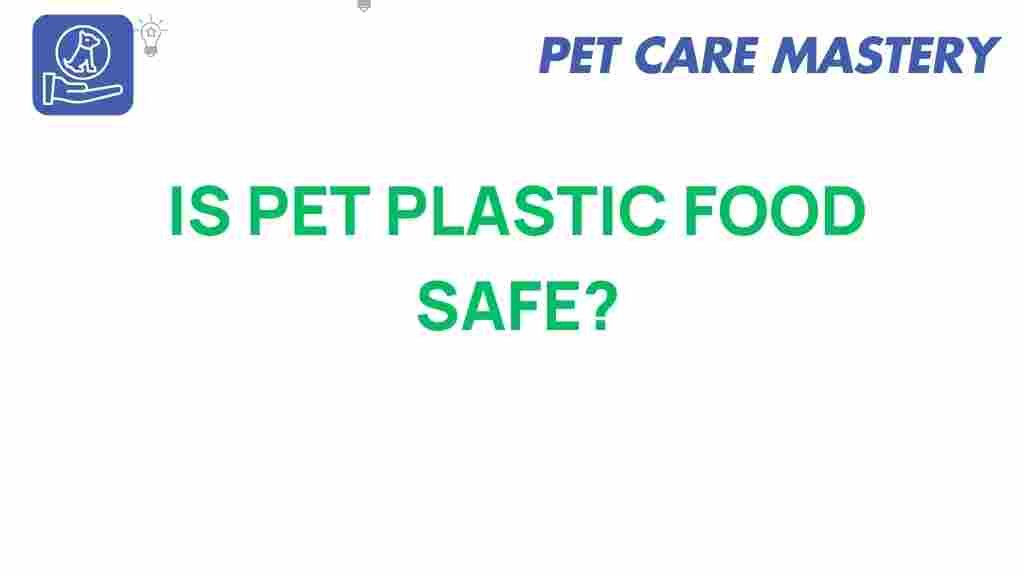Is Pet Plastic Food Safe? Understanding Pet Plastic Safety
In recent years, the use of plastic containers for pet food has become increasingly popular among pet owners. However, concerns regarding pet plastic safety have also emerged. As we explore the implications of using plastic for pet food storage and packaging, we will unveil the hidden risks that may be present. In this article, we will delve into the types of plastics commonly used, the potential dangers, and best practices for ensuring the safety of our beloved pets.
Understanding Plastics: What Are They Made Of?
Plastics are synthetic materials made from polymers. The properties of plastics can vary based on their composition, and this is crucial when considering their safety for food storage. Here are some common types of plastics used in pet food packaging:
- Polyethylene Terephthalate (PET or PETE): Often used for bottles and containers, this plastic is generally considered safe.
- High-Density Polyethylene (HDPE): Commonly used for milk jugs and detergent bottles, HDPE is also deemed safe for food contact.
- Polyvinyl Chloride (PVC): Used in some food packaging, PVC may contain harmful additives and is not recommended for long-term food storage.
- Low-Density Polyethylene (LDPE): Typically used for grocery bags and some food wraps, LDPE is considered safe.
- Polypropylene (PP): Often used for yogurt containers and straws, PP is also recognized as safe for food applications.
The Risks of Using Plastic for Pet Food
While many plastics are categorized as safe, there are hidden risks associated with certain types of plastic packaging. Understanding these risks is essential for ensuring pet plastic safety.
1. Chemical Leaching
One of the primary concerns with plastic food containers is the potential for chemical leaching. Some plastics can release harmful chemicals into food, especially when exposed to heat or sunlight. Here are some chemicals to be aware of:
- Bisphenol A (BPA): Found in some plastics, BPA has been linked to various health issues, including hormonal disruptions.
- Phthalates: These chemicals are often used to make plastics more flexible but may interfere with hormone function.
2. Bacterial Growth
Plastic containers can also harbor bacteria if not cleaned properly. Pet food left in plastic bowls can become a breeding ground for harmful bacteria, leading to potential health risks for pets.
3. Environmental Concerns
Plastic waste poses a significant environmental threat. When plastic containers are improperly disposed of, they contribute to pollution and can harm wildlife. Choosing environmentally friendly packaging alternatives can mitigate these risks.
Ensuring Pet Plastic Safety: Best Practices
To ensure pet plastic safety, pet owners should adopt certain practices when it comes to selecting and using plastic containers for pet food:
Step 1: Choose the Right Type of Plastic
When selecting plastic containers for pet food, opt for those made from safe materials like PET, HDPE, or PP. Avoid containers made from PVC or those that do not specify their material.
Step 2: Check for Labels
Always look for recycling codes on the bottom of containers. Codes 1 (PET), 2 (HDPE), 4 (LDPE), and 5 (PP) are generally considered safe for food storage.
Step 3: Avoid Heating Plastic
Do not microwave plastic containers unless they are labeled as microwave-safe. Heating can increase the risk of chemical leaching.
Step 4: Clean Regularly
Regularly wash plastic bowls and containers with hot, soapy water to prevent bacterial growth. Ensure that containers are thoroughly dried before refilling them with food.
Step 5: Store Food Properly
Store pet food in a cool, dry place and transfer it to an airtight container if it comes in a plastic bag. This will help reduce exposure to air and moisture, which can lead to spoilage.
Troubleshooting Tips for Pet Owners
If you suspect that your pet’s food or containers might be unsafe, consider the following troubleshooting tips:
1. Inspect the Packaging
Check for any signs of damage, such as cracks or discoloration. If the packaging appears compromised, it’s best to discard the food.
2. Monitor Your Pet’s Health
Be vigilant about your pet’s health. If you notice any unusual behavior, gastrointestinal issues, or lethargy, consult your veterinarian immediately.
3. Research Brands
Before purchasing pet food, research brands to ensure they use safe packaging materials and comply with pet food safety regulations. You can visit pet food safety resources for more information.
4. Consider Alternatives
If you are concerned about plastic safety, consider switching to glass or stainless steel containers for food storage. These materials are generally safer and more environmentally friendly.
Conclusion: Prioritizing Pet Plastic Safety
In summary, understanding pet plastic safety is crucial for the well-being of our pets. While many plastics are safe for food contact, there are potential risks associated with chemical leaching and bacterial growth. By following best practices such as choosing the right type of plastic, cleaning containers regularly, and monitoring your pet’s health, you can reduce these risks significantly.
Ultimately, being informed and proactive about pet plastic safety will help ensure the health and happiness of your furry companions. If you have further questions or concerns, feel free to consult with your veterinarian or explore more resources on pet safety.
For additional tips on keeping your pets safe, check out our article on pet health best practices.
This article is in the category Nutrition and created by PetCareMastery Team
